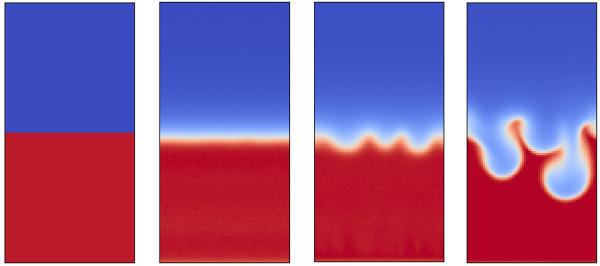Berkeley Lab’s Novel Method for Modeling Fluids at the Mesoscale
This tool could lead to solutions for catalysis, water purification, carbon capture, and more
May 22, 2023
By Linda Vu
Contact: cscomms@lbl.gov

Initiation and progress of a Rayleigh-Taylor instability triggered by thermal fluctuations.
Science Breakthrough:
How do a fluid’s atoms and molecules react during the boiling process, when heat is applied to a liquid until it transforms into gas? Or how do fluids generally behave at tiny scales (across tens of nanometers), smaller than the width of a strand of hair? The answers to these questions are surprisingly complex. And the mathematical models for understanding these dynamics remain incomplete. One approach for gaining insights into these dynamics is in the field of fluctuating hydrodynamics (FHD), which takes into account the movements (or fluctuations) of the fluid’s atoms and molecules.
Recently, Berkeley Lab researchers developed a continuum FHD model that efficiently harnesses the power of cutting-edge exascale supercomputers to simulate the transport phenomena (i.e., how fluid molecules transport mass, momentum, and energy) in fluid mixtures. The tool is especially effective for studying mesoscale events, ranging between nanometers and micrometers and at timescales between nanoseconds and microseconds. And it could help explore solutions for catalysis, water purification, carbon capture, and more. In January 2023, this paper was selected as the Physical Review E’s “Editor’s Suggestion.”
Science Background:
To predict how a fluid will behave at scales visible to the naked eye (macroscale), scientists must understand how its molecules move (microscale). And to gain microscale insights, scientists often rely on molecular dynamics methods. Although these methods can technically be used to model fluids at all scales, they require significant computing power; and no current supercomputer could ever run molecular dynamics simulations at practical length scales. So scientists develop continuum models to describe fluid flow that is observable with the naked eye.
But between the microscale and the macroscale, there is the mesoscale, where fluid behavior is strongly influenced by the thermal motion of its atoms and molecules. Even though many interesting phenomena happen at these length scales, modeling fluids at the mesoscale is a relatively new research area. Berkeley Lab researchers are developing novel methods that incorporate important microscale physical effects into continuum models to gain insights into mesoscale phenomena. The model proposed in this paper uses significantly fewer computational resources than traditional molecular dynamics simulations but is just as physically accurate in capturing mesoscale fluid dynamics.
Science Breakdown:
In this case, the team developed an exascale-compatible continuum FHD framework by constructing a GPU-optimized staggered-grid scheme that incorporates both the principles of classical fluid mechanics and nonequilibrium statistical mechanics to solve fluctuating Navier Stokes equations for a mixture of ideal gasses. The researchers found that their staggered-grid scheme more accurately reproduces the structure of hydrodynamic fluctuations than a previously proposed collocated scheme.
They also incorporated multispecies diffusion and thermal diffusion models into their framework, which are crucial for understanding how diffusion of each species occurs in a mixture of several gas species. They found that their method simulated the complicated giant fluctuation phenomenon and mesoscale Rayleigh-Taylor instability just as accurately as computationally expensive particle methods.
The team is now using their method to explore how these thermal fluctuations affect turbulence in fluids, which has traditionally been modeled using standard Navier-Stokes equations without thermal fluctuations. They are also engaged in coupling their method with surface chemistry models to simulate fluid catalysis near reactive surfaces.
Research Lead:
Ishan Srivastava, Berkeley Lab Applied Mathematics and Computational Research
Co-authors:
Daniel Ladiges, Andy Nonaka, John Bell: Berkeley Lab Applied Mathematics and Computational Research
Alejandro Garcia: Department of Physics, San Jose State University
Publication:
Staggered scheme for the compressible fluctuating hydrodynamics of multispecies fluid mixtures
Phys. Rev. E 107, 015305 – Published January 24, 2023
Related links:
Between Micro and Macro, Berkeley Lab Mathematicians Model Fluids at the Mesoscale
Funding:
The US Department of Energy, Office of Science, Office of Advanced Scientific Computing Research Applied Mathematics Program funded this work.
User Facilities:
About Berkeley Lab
Founded in 1931 on the belief that the biggest scientific challenges are best addressed by teams, Lawrence Berkeley National Laboratory and its scientists have been recognized with 16 Nobel Prizes. Today, Berkeley Lab researchers develop sustainable energy and environmental solutions, create useful new materials, advance the frontiers of computing, and probe the mysteries of life, matter, and the universe. Scientists from around the world rely on the Lab’s facilities for their own discovery science. Berkeley Lab is a multiprogram national laboratory, managed by the University of California for the U.S. Department of Energy’s Office of Science.
DOE’s Office of Science is the single largest supporter of basic research in the physical sciences in the United States, and is working to address some of the most pressing challenges of our time. For more information, please visit energy.gov/science.









